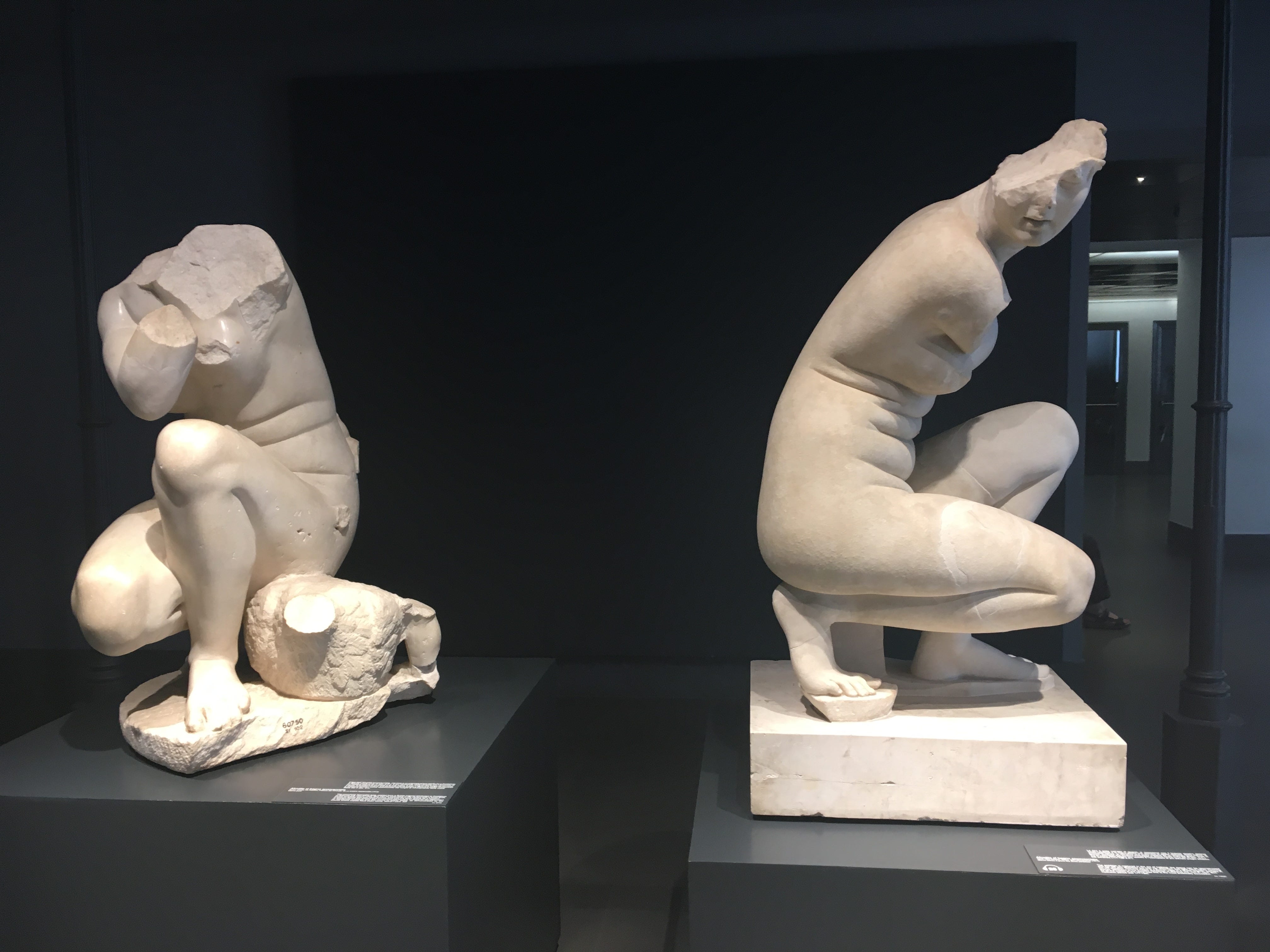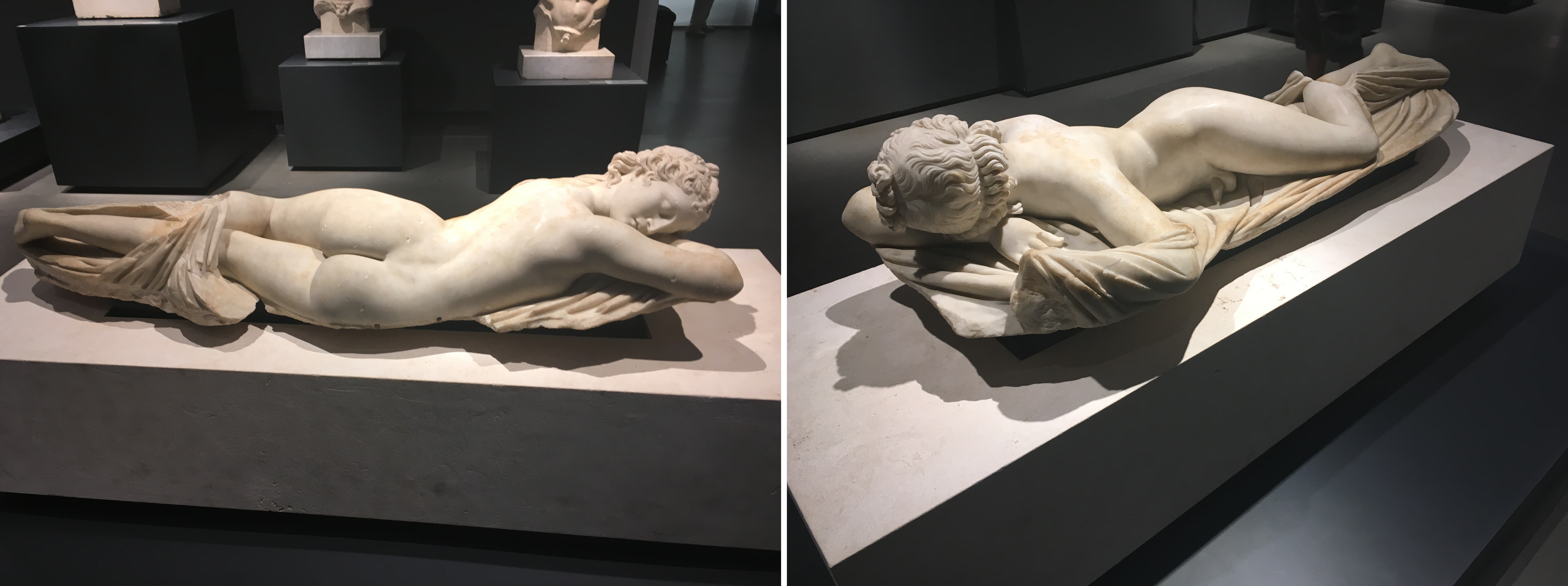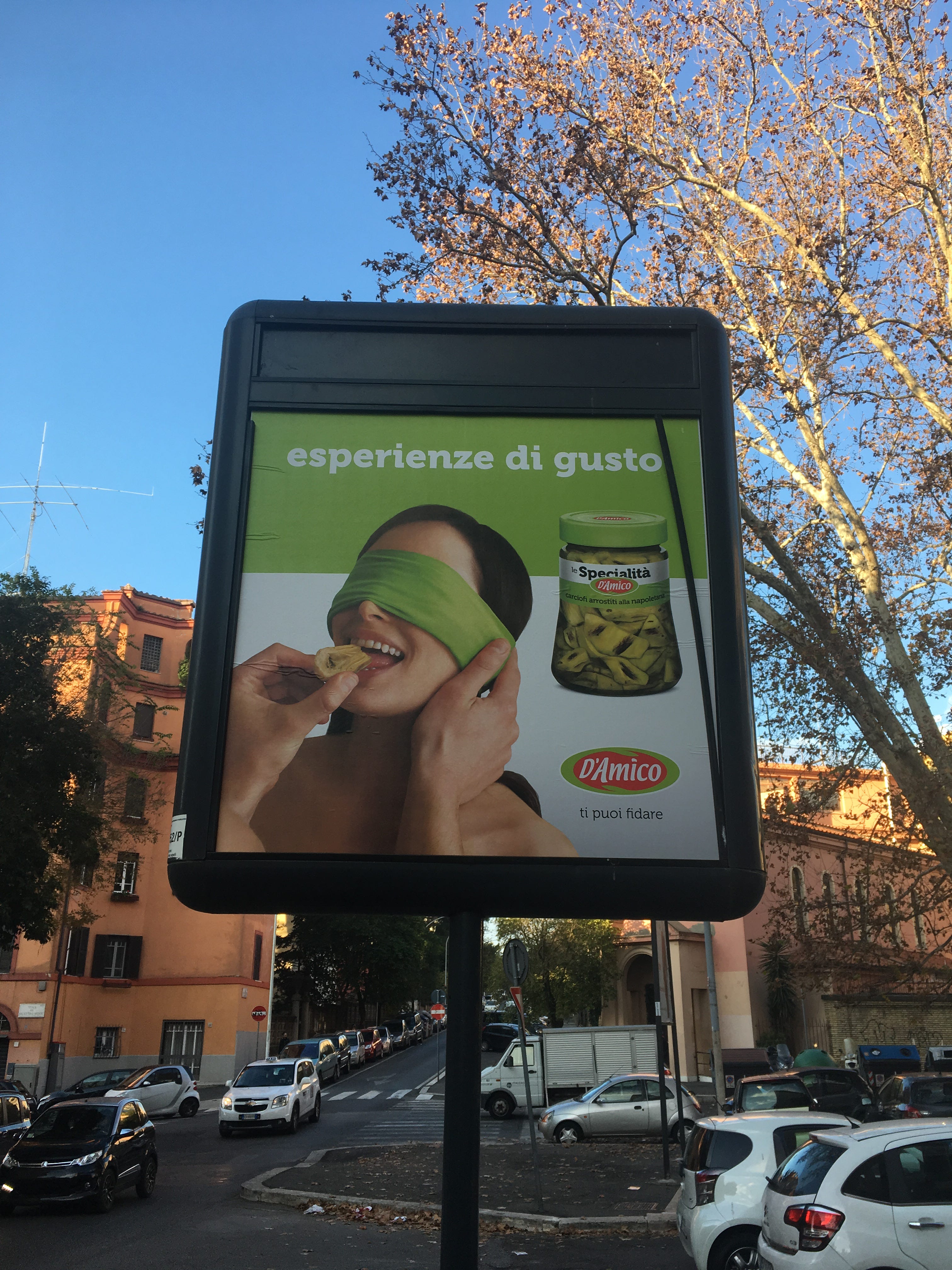29 “The Body in Question” by Grace Gillies (2019)
Medium. November 14, 2019. https://eidolon.pub/the-body-in-question-d28045d23714.
In high school and college, I used to spend summer days as one gender or the other. I was fascinated by my ability to “pass,” and to play with the nature of gender presentation. When I was male-passing, in my brother’s baggy old clothes and a baseball hat, I felt both attractive and pleasantly invisible on the city streets. I experimented with how frivolous a change I could make to tip my gendered balance one way or the other. I would be greeted with a confident “sir” at the local coffee shop — which would falter when I started speaking. My voice is girly.
But it wasn’t all fun and games. The biggest danger came from being “recognized” as a gender nonconforming woman. I faced harassment whether I looked like a woman or something else — men followed me, yelled at me, threw things at me, and worse — but there was an obvious difference in tone. Men who harrassed me while looked feminine wanted my attention. Men who harassed me for being too masculine considered my very existence disruptive. One time, a group of five men followed me for blocks, loudly debating two questions: whether they wanted to “fuck me” or not, and whether I was a man or a woman. It wasn’t the worst abuse I’ve ever received, but it was the most pointed: my gender confused them, and that made them angry.
By the time I moved to Rome in 2016 to teach at a Classics-focused study abroad program, I had grown out my hair, and regularly wore heels and makeup. Despite the extra work, pain, and money this presentation required, it felt easier. Still, I couldn’t shake an anxiety about my self-presentation. Gender can be a drag.

The focus of the program was on the material record of the Romans. We stared at shadows of ancient bodies over and over: their mirrors, their armor, their shackles, their bedrooms, their representations of themselves. Some of those representations came from the Museo Nazionale Romano di Palazzo Massimo, which is home to an impressive collection of statues from the Roman world.
Our students were asked to consider the individuality of the statues. Many Roman statues are described as “copies” of Greek originals, but the collection emphasizes works as individual interpretations. The statues stand stripped of paint and their original context, pale under the spotlights against the stark grey walls. Placed side by side, it is easy to see small but weighty differences between them: the unique rolls of belly fat in a crouching Venus, the varied musculature of the Discoboulos. The effect is an unsettling conviction that these are real people.

In one of the rooms lies a sleeping Hermaphroditus. The statue resists panoptic interpretation — the viewer may approach from all sides, but with only a limited view, in order to surprise the viewer as they walk around it. At the same time, Hermaphroditus lies naked and unconscious for the viewer to expose at will. The statue is a succinct commentary on sex, gender, and the presentation of bodies. It is also a joke.

John Berger has argued that looking is gendered, and that those assigned female at birth are conditioned to survey themselves at every second, in every context: “Men look at women. Women watch themselves being looked at.” He differentiates between “nakedness,” which is simply the state of having no clothes on, and “nudity,” which is the display of the undressed body. Men may be naked, but women are at most nude, since they are told to be constantly aware of how they look even when they are alone. As I looked at these statues, I became aware that I was looking at myself — how did I compare? Which one of these images was I? As viewer and viewed blurred, Hermaphroditus seemed an especially poignant example, since the figure is made nude over and over again, as the viewer approaches from different sides.

Working in Italy provided its own pressures of viewership. The Italian staff at the program were always extremely kind, but the broader Italian attitude to gender and especially femininity seemed dauntingly conservative. When I arrived, Italy was in the throes of a campaign to increase the national birthrate by shaming (cisgender) women into giving birth. Directly outside the school, an ad for a food company showed a nude, blindfolded woman being held and fed by disembodied hands reaching out from behind the camera. Breathlessly, the woman awaits … pickled artichokes.
A joke. A succinct commentary on gender and the presentation of bodies.

As any beginner Latin or Greek student knows, all nouns have a gender. After that, it gets more complicated. The Greek and Roman canon both feature figures who switch from one gender to another, subvert gender roles, or otherwise refuse the gender binary. These characters’ genders are rarely unmarked and frequently problematized. During my research on Roman satire, I became steeped in invective against those who resist gender norms: tribades, women who act like men, especially by having sex with women; molles or effeminate men; and cinaedi, men who act effeminately and “passively” have sex with men.
During high school and college I had no real language for my gender experiments, but I recognize them now as early explorations of nonbinary gender identity. “Nonbinary” and “genderqueer” are flexible umbrella terms for gender identities outside of the Western binary of male and female. This can include transgender people, depending on how they define their own gender. Some people identify only as nonbinary or genderqueer, others as something more specific: blurring genders together, having more than one gender, inhabiting a third gender, or rejecting gender altogether.
As I looked at the statue of the sleeping Hermaphroditus, I was reminded of Lucian’s Dialogue of the Courtesans 5. In this dialogue, a sex worker Leaina explains to her curious friend Klonarion the details of her encounter with Megillos, who uses a masculine name and both feminine and masculine case endings (to respect this mixed usage but maintain clarity, I will use “they” to refer to Megillos). Although Megillos is never actually present, the mime reads like a striptease of them, slowly revealing the details of their body and desires. Leaina explains that she was hired by “Megilla” and Demonassa, to provide music for a drinking party. After the party, she winds up in bed with both of them (all translations my own):
LEAINA: Eventually Megilla, by now very hot, took off her wig, which fit very tightly and was very realistic, and was revealed to have hair cropped close to her skin, just like male athletes. I was shaken when I saw this. But Megilla said, “Leiana, have you ever seen such a beautiful young man?”
“But I don’t see any man here, Megilla,” I said.
“Don’t feminize me!” she said. “My name is Megillos, and I married this woman Demonassa a long time ago — she’s my wife.”
Central to the dialogue is the unsolvable riddle of Megillos’s body, a common theme for invective works written by men about women who have sex with women — how do they do it? Is she a man? Is she a woman? Is she a pickled artichoke?
Megillos’s insistence on aspects of both male and female genders, however, fits with a nonbinary gender identity. Leaina uses feminine endings to refer to Megillos, but Megillos refers to themself in both masculine and feminine terms, and more importantly refuses to resolve the tension this creates — they’re a “young man” (νεάνισκος) but not male, feminine but not a woman.
While I was teaching students to look at the ancient world, I was also teaching Medea to an intermediate Greek class. I had read the play and taught tragedy before, but the play began to take on a personal dimension. I pictured a Greek man playing a Greek woman who resents the values and body associated with being a Greek woman. “I’d rather fight behind a shield three times than give birth once,” Medea says to a crowd of Corinthian women, all men. At the end of the play, Medea has kept her word, killed her children, and surpassed all human boundaries. Victorious, she flies off in her grandfather’s fire chariot. My students and I discussed Froma Zeitlin’s classic interpretation of this finale: that Medea is so far beyond the gender binary that there is no place for her on earth. Megillos isn’t magic or tragic or even angry. So where do they belong?
Some of the students created a Greek-mythology themed roleplaying game, and earnestly suggested I would be a fitting Medea. I wrestled with this.
The mime of Megillos ends with one last clue about what Megillos’s body looks like, and how they act out their gender identity, and then one last denial of the juicy details:
LEAINA: “Give me what I want,” Megillos said, “if you don’t believe me, and you’ll see that I don’t fall short of any man — because I have something in place of what men have. Just let me, you’ll see.”
I gave in, Klonarion, because she was begging me so much, and offered me a necklace, the expensive kind, and very fine linen dresses. Then I embraced her like she was a man, and she went to work, and kissed me, and panted, and seemed to enjoy herself to the extreme.
KLONARION: What did she do, Leaina — or how did she do it? Please tell me that.
LEAINA: No, don’t ask me for the details, they’re shameful. By the goddess in heaven, I’d never talk about that.
Like Hermaphroditus, the dialogue is meant to be a joke. But the final note is shame — these acts, this gender, this body, is shameful. Shame is the most persistent theme of invective about genderqueer and nonbinary people. Shame was what people who yelled at me in the street were trying to inflict on me.
This is not to say that there are no examples of real gender non-conforming people from the ancient world who lived without shame. The Galli, for instance, were Roman priests of Cybele who castrated themselves and in many ways presented themselves as women. They have been interpreted as predecessors to transwomen, and although their office was highly regulated, they appear to have had a stable niche in Roman society. But in Roman literature, their gender is the result of—and intrinsically tied to—violence. At the end of Catullus’s story of Attis (poem 63), who castrates herself for Cybele in a frenzy, Attis uses feminine case endings but is filled with regret:
Am I to be called a maid of the gods, a female slave of Cybele?
Will I be a Maenad, a fragment of myself, a man unmanned …
Now at last I regret what I did, now at last I am ashamed.
In response, Cybele drives her mad. In 2017, gender dysphoria is still classified as a mental disorder. Experiences of violence, including sexual violence, and suicide rates are already disproportionately high amongst transgender and gender non-conforming people, and only increasing. These are hard statistics, with a long history.

In the center of the second floor at the Palazzo Massimo are two statues of Apollo and Dionysus. They are both shown as handsome youths, lounging nonchalantly and staring down at passersby from their pedestals. Both inhabit the idealized in-between state of male youth: after childhood but before they grow the facial hair that will make them men. They have long hair, hairless faces, and fragmented genitals. Although their iconography is identifiable, in the context of the collection it is easy to see them as just two more bodies. They seemed like androgynous bodies to me, and that androgyny seemed unremarkable beyond the fact that it made them beautiful. I liked them. I wanted to identify with them.

This feeling was unsettling. Others have discussed the potential importance of Dionysus for genderqueer people, but I had never considered either of them as anything other than male. Both are praised for feminine beauty, but ultimately exhibit traditional and even toxic masculinity. One of my earliest forays into Latin literature had been Ovid’s story of Apollo and Daphne, in which Apollo enjoys Daphne’s fear and revulsion. As a scholar, I prided myself on looking for the meat of the ancient world, on insisting on all of its ugliness, on refusing to put the ancient world on a pedestal — and here I was, literally admiring it on a pedestal.
Also, I should add, I am not a man — and definitely not a ripped, godly one.
And yet. These statues were created to depict men in the liminal stage of male youth, and had been further destabilized by the vagaries and violence of time. Each was a νεάνισκος, the same word that Megillos had chosen for themself.
Unlike Megillos, however, the statues were not created for the purpose of shame.
I do see myself in Megillos, in Hermaphroditus, in Attis, and in Medea. I see them as icons in a history of othering and shame. I see them as people to claim and reclaim for the history of queer gender. The current language of nonbinary gender is relatively new, which can make us seem like a people without a history — it is essential to acknowledge that we have a history, and that it is riddled with exclusion, violence, disgust, and haunting lacunae.
At the same time, that very history makes it all the more essential to find ways to ease its weight. In looking at those two bodies as murky reflections of myself, I knew I was rewriting history — something I had sworn to avoid as a historian. But integral to many genderqueer people’s lives are episodes of personal rebirth and rewritten history. For me, that episode was in staring at two bodies in which I saw an unashamed version of myself. It felt like a new history. It felt like rebirth.

Grace Gillies is a PhD candidate at UCLA, and works on Roman street culture as well as queer history.
